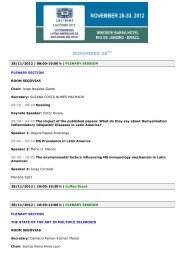Keynote Conference - Interevent
Keynote Conference - Interevent
Keynote Conference - Interevent
You also want an ePaper? Increase the reach of your titles
YUMPU automatically turns print PDFs into web optimized ePapers that Google loves.
Symp#3 Gene Therapy<br />
Chair Martin Bonamino<br />
Gene Therapy of Limb Ischemia with GM-CSF<br />
Sang Won Han<br />
Department of Biophysics, Federal University of São Paulo, São Paulo, Brazil<br />
Peripheral arterial diseases (PAD) affect about 1000 per million every year and about 200 of them suffer limb<br />
amputations. The PAD incidence increases in the case of diabetic patients and people with more than 60 years. Therefore,<br />
PAD has a high socio-economic and medical impact today. Approximately half of critical limb ischemic patients can be<br />
treated by vascular surgery, but the remainder depends mainly on the velocity of adaptation of the existing collateral<br />
vessels, a process known as arteriogenesis.<br />
Several growth factors, cytokines and proteases are required for arteriogenesis, which is the process of remodeling preexistent<br />
vessels during the ischemia. The monocytes, attracted by the presence of tumor necrosis<br />
factor-α and monocyte chemoattractant protein-1 at the inflammatory sites, are the main producers of factors for<br />
arteriogenesis. The time and concentration of the factors required to complete arteriogenesis varies in each case of PAD,<br />
consequently the action of the activated monocytes may not be enough to resolve the ischemic problem. One way to<br />
prolong the life of monocytes is by inhibiting apoptosis by granulocyte-colony-stimulating factor (GM-CSF), which is a<br />
hematopoietic-stimulator that enhances the survival, proliferation and rate of differentiation of hematopoietic cells.<br />
In my presentation, therapeutic effects of GM-CSF in limb ischemia by gene therapy will be presented and discussed.<br />
A Hematopoietic Stem Cell (HSC) Specific microRNA Gives Novel Insights into the Regulation of HSC Homeostasis and<br />
Allows Safer HSC-based Gene Therapy<br />
Bernhard Gentner 1,2 , Alice Giustacchini 1,2 , Ilaria Visigalli 1 , Eric Lechman 3 , Peter van Galen 3 , Hidefumi Hiramatsu 3 , Francesco<br />
Boccalatte 1,2 , Massimo Saini 1 , Silvia Ungari 1,2 , John E Dick 3 , Alessandra Biffi 1 and Luigi Naldini 1,2 .<br />
1 San Raffaele Telethon Institute for Gene Therapy; 2 Vita-Salute San Raffaele University, San Raffaele Scientific Institute,<br />
Milan, Italy; 3 Division of Stem Cell and Developmental Biology, University of Toronto, Toronto, Ontario<br />
We report that miR-126, a microRNA preferentially expressed in Hematopoietic Stem Cells (HSC) among the<br />
hematopoietic lineage, plays a pivotal role in restraining cell cycle progression of HSC in vitro and in vivo. miR-126<br />
knockdown expanded functional mouse and human HSC in vivo, without HSC exhaustion. Conversely, enforced miR-126<br />
expression increased the fraction of phenotypic HSC in G 0. miR-126 control of proliferation is attributable, in part, to<br />
attenuation of signal transduction by the PI3K/AKT/GSK3β axis. We propose that miR-126 establishes a threshold for HSC<br />
activation and provides negative feedback aiding the return of stimulated HSC to quiescence. Our results establish that<br />
the HSC quiescence/activation equilibrium is regulated by miRNAs in a mechanism conserved between mouse and human.<br />
The discovery of HSC-specific microRNAs also prompted us to design novel vectors for HSC-mediated gene therapy with<br />
enhanced efficacy and safety. By adding miR-126 target sequences (miRT) to a vector cassette, miR-126 activity was<br />
harnessed to negatively regulate transgene expression in HSC and target expression to differentiated hematopoietic cells.<br />
These HSC-off vectors allow delivering a transgene into HSC without affecting its proteome, while achieving sustained<br />
multi-lineage expression in the progeny. The utility of this new vector was demonstrated for the gene therapy of Krabbe<br />
disease in the mouse model. miR-126 regulated vectors overcame hematopoietic toxicity associated to unregulated<br />
galactocerebrosidase (GALC) expression in HSC, while delivering substantial amounts of GALC enzyme in the nervous<br />
system with improved survival of the affected mice.<br />
Conditional models for Chimeric Antigen Receptor (CAR) based activation of T lymphocytes<br />
Martin Bonamino<br />
Instituto Nacional de Cancer – Rio de Janeiro – Brazil<br />
The modification of T lymphocytes with Chimeric Antigen Receptors (CARs) represents a promising strategy for combined<br />
adoptive T cell based immune-gene therapy of cancer. Current CAR molecules are constructed fusing an immunoglobulinderived<br />
Fab-based antigen recognition domain in the scFv configuration, a transmembrane domain and signaling domains<br />
promoting T cell activation. Clinical trials based on this strategy have reported impressive hematological responses for<br />
leukemia and lymphomas for CARs designed against CD19, CD20 or CD30 antigens.<br />
One potential limitation of this strategy is the off-target effects observed when target antigens are expressed in healthy<br />
tissues. To circumvent this limitation we are considering conditional activation based on two CARs in a way that only the<br />
correct antigen combination induces complete T cell activation. This strategy has the potential to expand the panel of<br />
CAR-targeted antigens, narrowing T cell responses based on CAR mediated antigen recognition and increasing the safety<br />
of CAR-based immune-gene therapies.<br />
55





